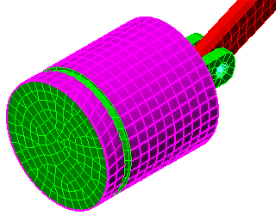- Click the
 Home icon above the ViewCube for an isometric view of the model.
Home icon above the ViewCube for an isometric view of the model. - With the
 Selection
Selection Shape
Shape Point or Rectangle and
Point or Rectangle and  Selection
Selection Select
Select Surfaces commands active, click one of the two cylindrical surfaces at the outside diameter of the piston.
Surfaces commands active, click one of the two cylindrical surfaces at the outside diameter of the piston. - Hold down the Ctrl key and click the remaining outside diameter surface. The piston should appear as shown below.

- Hold down the Ctrl key and click the remaining outside diameter surface. The piston should appear as shown below.
- Click
 Setup
Setup Constraints
Constraints General Constraint.
General Constraint. - Activate the Tx and Tz checkboxes. The piston is only free to translate in the Y direction.
- Click OK.
- Right-click the Part 3 heading in the browser (tree view) and choose Select Related
 Surfaces. All of the surfaces of Part 3 are now selected.
Surfaces. All of the surfaces of Part 3 are now selected. - Click
 Setup
Setup Constraints
Constraints General Constraint.
General Constraint. - Activate the Tx checkbox.
- Click OK. The crank is free to move only in the Y and Z directions. Though not absolutely necessary, this constraint stabilizes the crank by preventing any twisting or bending that might occur from flexure of the joints. It also makes convergence of the solution a little easier, and therefore speeds up the simulation.